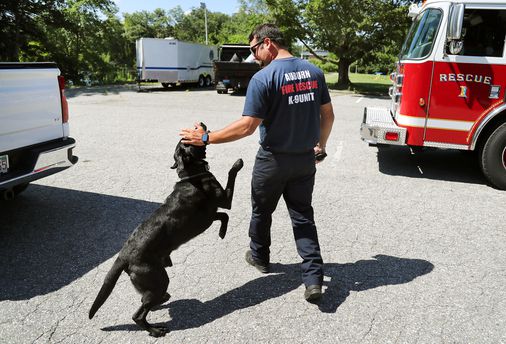Using these coordinates, it took a diver 10 minutes to locate Orbe Quito’s underwater resting place.
Hopkinton Fire Chief Gary Daugherty Jr., who coordinated the response, said he was involved in about a dozen water rescue operations, but this was the first time a dog had been used.
Riggs ran out of a small pond behind the Auburn fire station.John Tlumacki/Globe Staff
“Any time I have a recover or missing person, I will use a dog from now on,” Daugherty said.
Ethier has prepared Riggs for such dark but important missions since Riggs was a pup. Riggs has done remarkably well at his job: This was his 10th successful assist since 2020, Ethier said.
But Ethier is quick to say her role is just part of a much larger operation that often involves dozens of emergency responders.
“We’re not looking for recognition. “We want to educate the families and end the search,” he said.

Humans have relied on dogs’ keen sense of smell for centuries, but it’s only in the last few decades that researchers and the working dog community have begun to develop sophisticated training methods for so-called cadaver dogs.
Law enforcement agencies in the United States began training dogs to find human remains in the 1970s. Recently, researchers have found that dogs can be trained to locate much older remains buried underground, including black and indigenous burial sites, some dating back more than 9,000 years.
As bodies decompose, they release organic compounds that create hundreds of odors. cadaver dogs are trained to locate the “strongest source” of odors emanating from human remains while ignoring odors emanating from other animals. In the case of underwater remains, the odors have usually penetrated to the water surface there.
 Matt Ethier played with Riggs at the fire station. John Tlumacki/Globe Staff
Matt Ethier played with Riggs at the fire station. John Tlumacki/Globe Staff
The Massachusetts State Police has four cadaver dogs and one more in training, but does not maintain a statewide database of all dogs with volunteer teams or dogs like Riggs that are members of the local police force or fire department, spokesman David Procopio said.
Three volunteer groups in the state have human-canine teams that can be called to assist in locating people, living or deceased. They have another 14 certified cadaver dogs, officials from the groups told the Globe.
“Most local and state governments just can’t allocate the money for something that’s so rare, so many places rely heavily on those few dogs or volunteers,” said Tyler Bresse, chair of the Massachusetts State Search and Rescue Dog Federation. a coalition of volunteer teams.
Between materials and travel expenses, Bresse estimates that volunteers can spend thousands of dollars a year training their dogs in cadaver recognition. To maintain their skills, the dogs must exercise at least 16 hours a month in different environments.
“When you start including water [training]the cost of boats, add a few thousand dollars,” he said.
Through his work, Ethier had ample opportunity to engage Riggs in real land and sea operations. But he said he paid all other expenses out of pocket for the first two years of the training and is still looking for training materials. Actual human remains are used in the training. Ethier said he orders human bones and perfume bottles from private companies and collects other specimens from family and friends.

A well-trained dog can outperform legions of helpers and high-tech equipment when it comes to locating someone, living or dead.
“I’ve personally seen several times the helicopters, the drones and all these high tech resources were out and within 20, 30 minutes after the dog was out the person or body was found,” Bresse said.
“You won’t be able to hide from the dog,” said Bresse. “It’s the smell, nothing visual.”
Quito, the youngest drowning victim, was reported missing around 8 p.m. on July 21 by a friend who went swimming with him, said Daugherty, the Hopkinton chief. Soon, dozens of his family and friends huddled under a white tent in the parking lot of the small local beach while dozens of divers with the Massachusetts Fire District 14 technical rescue team, aided by sonar-equipped boats, swept the bottom of the pitch-black sea, densely overgrown .
But a torrential downpour and lightning halted the search several times, and by midnight it was too unsafe to proceed.
When Ethier and Riggs arrived at 7:10 a.m. that morning, Orbe Quito’s group and dozens of divers and emergency responders were already on site, hoping the dog might help narrow the search.
The most important part of the search came after Orbe Quito’s body had been pulled from the water and most of the responders had left the water. His family, friends and the priest stood together on the beach and said prayers together in Spanish. His mother and father joined in via video call from Ecuador, said the priest, Rev. Peter Joyce.
“They were very close; They obviously took care of him,” Joyce said, adding that his family wants to bring his body home to Ecuador for burial.
Sarah Ryley can be reached at sarah.ryley@globe.com. Follow her @MissRyley.


Comments are closed.